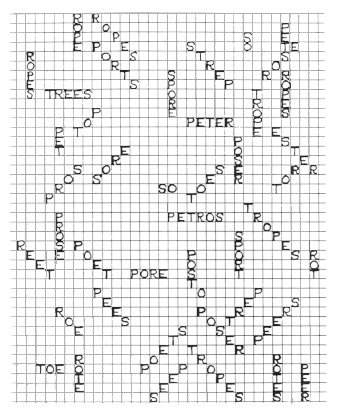
Jackson Mac Low: Vocabulary Gatha for Pete Rose, the recorder virtuoso composer of Maplewood N.J., who plays only contemporary music. Copyright 1978, 1983, and 2002 by Jackson Mac Low. All rights reserved. Actual size: 8.5 inches by 11 inches.
A { color: black ;text-decoration:none} A:hover {color:red}
The Gatha may be performed by a single performer or by a group of any size.
Each performer starts at any square & moves from there to any adjacent one,
horizontally, vertically, or diagonally, & thence to other squares. Each
letter or group of letters (joined in any direction(s)) may be spoken,
sung, or played on a musical instrument. All three ways of realizing the
Gatha shd occur during a performance.
Vocal possibilities include the speaking or singing of the letters'
individual sounds (as they are pronounced in any language known to the
performer), the letters' English names (e.g. "oh" or "tee"), any
syllables formed by letters adjacent in any direction(s), & whole words.
Any of these elements may be performed ad lib. The name "Pete
Rose" may be spoken or sung at any time, & the performer may then
jump to a square not adjacent to the last one realized. In singing the
performer may either sing pitches assigned to letters for instrumental
realization (see below) or freely choose pitches in accord with the
performance situation.
When playing an instrument, the performer moves from square to square
as above, but realizes each letter as an instrumental tone, choosing
the octave in which each tone is placed. The letters occurring in the
Gatha are realized as follows:
The performer chooses between alternative pitches for each letter, or
trills or wavers between them, & connects tones consecutively or
simultaneously as their letters lie adjacent in any direction(s).
Letter tones may be repeated, adjacent ones trilled, & any group may
be repeated or reversed. Tones may be connected by glissandi
as well as being played discretely. Empty squares are rendered as
silences.
Each performer must listen intently to all sounds audible, including
those produced by other performers (if any), by the audience, or by
elements in the environment. Performers must relate with these sounds
in producing their own, exercising sensitivity, tact, & courtesy, so
that every performance detail contributes to a total sound sequence
they would choose to hear. Virtuosity is strongly encouraged but must be
exercised with consciousness of its place in the total aural situation.
Performers must be both inventive & sensitive at all times. "Listen"
& Relate" are the most important "rules."
All parameters not specified above, including octave placement,
simultaneous &/or successive grouping, repetition, duration, rhythm,
loudness, tempo, timbre, attack, &c,. are at the discretion of the
performer & are to be chosen spontaneously during a performance.
A performance may be ended at any time within the limits set by the
performance situation. A total duration may be set beforehand or arrived
at spontaneously. A group may appoint a leader to signal the beginning,
keep track of elapsed time with a watch, & signal the end of the
performance.
Performance Instructions for A Vocabulary Gatha for Pete Rose
P is played as B or B flat/A sharp.
E " E " E flat/D sharp.
T " D " D flat/C sharp.
R " A " A flat/G sharp.
O " G " G flat/F sharp.
S " C " F.